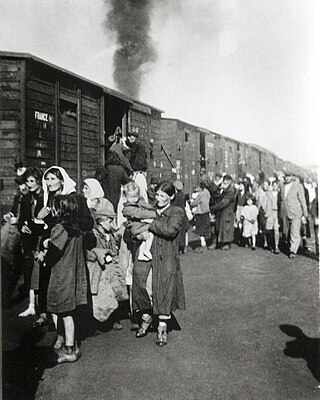
Operation Reinhard or Operation Reinhardt was the codename of the secret German plan in World War II to exterminate Polish Jews in the General Government district of German-occupied Poland. This deadliest phase of the Holocaust was marked by the introduction of extermination camps. The operation proceeded from March 1942 to November 1943; around 1.47 million Jews were murdered in just 100 days from July to October 1942, a rate approximately 83% higher than the commonly suggested figure for the kill rate in the Rwandan genocide.

Majdanek was a Nazi concentration and extermination camp built and operated by the SS on the outskirts of the city of Lublin during the German occupation of Poland in World War II. It had seven gas chambers, two wooden gallows, and some 227 structures in all, placing it among the largest of Nazi concentration camps. Although initially intended for forced labor rather than extermination, it was used to murder people on an industrial scale during Operation Reinhard, the German plan to murder all Polish Jews within their own occupied homeland. In operation from 1 October 1941 to 22 July 1944, it was captured nearly intact. The rapid advance of the Soviet Red Army during Operation Bagration prevented the SS from destroying most of its infrastructure, and Deputy Camp Commandant Anton Thernes failed to remove the most incriminating evidence of war crimes.
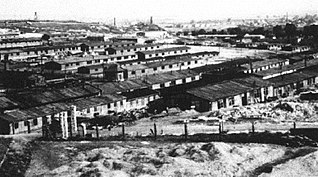
The German camps in occupied Poland during World War II were built by the Nazis between 1939 and 1945 throughout the territory of the Polish Republic, both in the areas annexed in 1939, and in the General Government formed by Nazi Germany in the central part of the country (see map). After the 1941 German attack on the Soviet Union, a much greater system of camps was established, including the world's only industrial extermination camps constructed specifically to carry out the "Final Solution to the Jewish Question".

Operation Harvest Festival was the murder of up to 43,000 Jews at the Majdanek, Poniatowa and Trawniki concentration camps by the SS, the Order Police battalions, and the Ukrainian Sonderdienst on 3–4 November 1943.
The Białystok Ghetto uprising was an insurrection in the Jewish Białystok Ghetto against the Nazi German occupation authorities during World War II. The uprising was launched on the night of August 16, 1943 and was the second-largest ghetto uprising organized in Nazi-occupied Poland after the Warsaw Ghetto Uprising of April–May 1943. It was led by the Anti-Fascist Military Organisation, a branch of the Warsaw Anti-Fascist Bloc.

Trawniki is a village in Świdnik County, Lublin Voivodeship, in eastern Poland. It is the seat of the present-day gmina called Gmina Trawniki. It lies approximately 24 kilometres (15 mi) south-east of Świdnik and 33 km (21 mi) south-east of the regional capital Lublin, and the river Wieprz flows by it.

The Nisko Plan was an operation to deport Jews to the Lublin District of the General Governorate of occupied Poland in 1939. Organized by Nazi Germany, the plan was cancelled in early 1940.

The Trawniki concentration camp was set up by Nazi Germany in the village of Trawniki about 40 kilometres (25 mi) southeast of Lublin during the occupation of Poland in World War II. Throughout its existence the camp served a dual function. It was organized on the grounds of the former Polish sugar refinery of the Central Industrial Region, and subdivided into at least three distinct zones.

The Izbica ghetto was a Jewish ghetto created by Nazi Germany in Izbica in occupied Poland during World War II, serving as a transfer point for deportation of Jews from Poland, Germany, Austria and Czechoslovakia to Bełżec and Sobibór extermination camps. The ghetto was created in 1941, although the first transports of Jews from the German Reich started arriving there as early as 1940. Izbica was the largest transit ghetto in the Lublin reservation, with a death rate almost equal to that of the Warsaw ghetto. SS-Hauptsturmführer Kurt Engels, known for his exceptional cruelty, served as its only commandant.
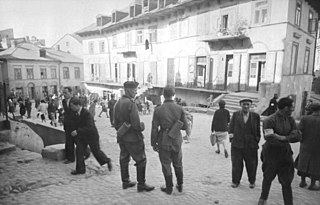
The Lublin Ghetto was a World War II ghetto created by Nazi Germany in the city of Lublin on the territory of General Government in occupied Poland. The ghetto inmates were mostly Polish Jews, although a number of Roma were also brought in. Set up in March 1941, the Lublin ghetto was one of the first Nazi-era ghettos slated for liquidation during the deadliest phase of the Holocaust in occupied Poland. Between mid-March and mid-April 1942 over 30,000 Jews were delivered to their deaths in cattle trucks at the Bełżec extermination camp and additional 4,000 at Majdanek.
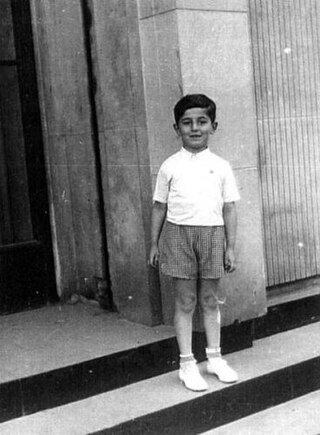
Henio Zytomirski was a Polish Jew, who was murdered at the age of 9 in a gas chamber at Majdanek concentration camp during the German Nazi occupation of Poland. Henio became an icon of the Holocaust, not only in Lublin but all over Poland. His life story became a part of the curriculum taught in the general education system in Poland. The "Letters to Henio" project has been held in Lublin since 2005. Henio Zytomirski is one of the heroes of "The Primer" permanent exhibition at barrack 53 of the Majdanek Museum, an exhibition dedicated to children held in the camp.
Poniatowa concentration camp in the town of Poniatowa in occupied Poland, 36 kilometres (22 mi) west of Lublin, was established by the SS in the latter half of 1941, initially to hold Soviet prisoners of war following Operation Barbarossa. By mid-1942, about 20,000 Soviet POWs had perished there from hunger, disease and executions. The camp was known at that time as the Stalag 359 Poniatowa. Afterwards, the Stammlager was redesigned and expanded as a concentration camp to provide slave labour supporting the German war effort, with workshops run by the SS Ostindustrie (Osti) on the grounds of the prewar Polish telecommunications equipment factory founded in the late 1930s. Poniatowa became part of the Majdanek concentration camp system of subcamps in the early autumn of 1943. The wholesale massacre of its mostly Jewish workforce took place during the Aktion Erntefest, thus concluding the Operation Reinhard in General Government.

Karl Streibel was the second and last commander of the Trawniki concentration camp – one of the subcamps of the KL Lublin system of Nazi concentration camps in occupied Poland during World War II.
German Equipment Works was a Nazi German defense contractor with headquarters in Berlin during World War II, owned and operated by the Schutzstaffel (SS). It consisted of a network of requisitioned factories and camp workshops across German-occupied Europe exploiting the prisoner slave labour from Nazi concentration camps and the Jewish ghettos in German-occupied Poland. DAW outfitted the German military with boots, uniforms and materials on the eastern front at a windfall profit, and provided wood and metal supplies, as well as reconstruction work on railway lines and freight trains.

During World War II, Trawniki men were Central and Eastern European Nazi collaborators, consisting of either volunteers or recruits from prisoner-of-war camps set up by Nazi Germany for Soviet Red Army soldiers captured in the border regions during Operation Barbarossa launched in June 1941. Thousands of these volunteers served in the General Government territory of German-occupied Poland until the end of World War II. Trawnikis belonged to a category of Hiwis, Nazi auxiliary forces recruited from native subjects serving in various jobs such as concentration camp guards.
Reserve Police Battalion 101 was a Nazi German paramilitary formation of the uniformed police force known as the Ordnungspolizei, the organization formed by the Nazi unification of the civilian police forces in the country in 1936, placed under the leadership of the SS and grouped into battalions in 1939. One of many such Nazi German Order Police battalions, 101 was formed in Hamburg and was deployed in September 1939 along with the German armed forces (Wehrmacht) in the invasion of Poland.

Többens and Schultz was a Nazi German textile manufacturing conglomerate making German uniforms, socks and garments in the Warsaw Ghetto and elsewhere, during the occupation of Poland in World War II. It was owned and operated by two major war profiteers: Fritz Emil Schultz from Danzig, and a convicted war criminal, Walter C. Többens.
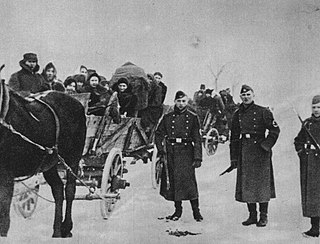
During the Holocaust, 99% of the Jews from Lublin District in the General Governorate of German-occupied Poland were murdered, along with thousands of Jews who had been deported to Lublin from elsewhere. There were three extermination camps in Lublin District, Sobibor, Belzec, and Majdanek.
Georg Wilhelm Johannes Michalsen was a German SS-Sturmbannführer. During the Second World War, he was involved in the systematic deportation and murder of Polish Jews and later served as the SS and Police Leader in Trieste. Decades after the war, he was tried as an accomplice to murder, convicted and sentenced to twelve years in prison.













